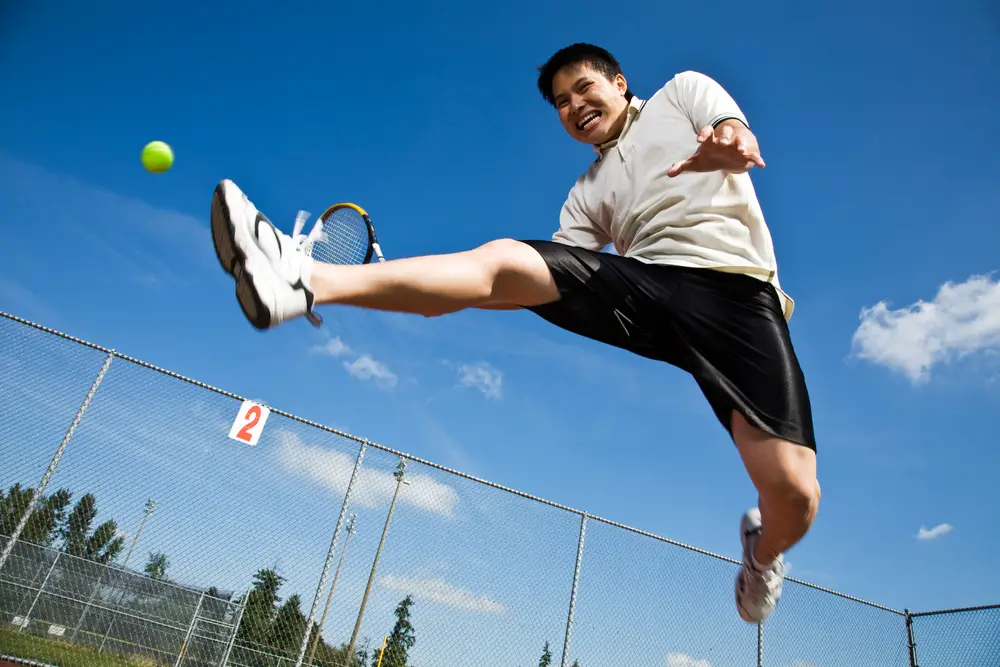Tennis is a racket sport. So it’s apparent that it is better to hit the tennis ball with a racket instead of your body.
The same is true for football because it is better to use your foot than any other body part. Despite this, using the head and chest are common in football.
Football tennis is a hybrid version of tennis and football. It is played on a tennis court using a football. There are several variations, but a common one is this.
Two teams of players will stand on each side of the net, trying to kick the ball over the net and onto the other side.
When the ball starts rolling, the point ends. This sounds like fun but are you allowed to kick a tennis ball over the net in a point of tennis?
You are not allowed to kick a ball over the net in tennis during a point under any circumstances. The ITF rules of tennis state that a player loses the point if “the ball in play touches the player or anything that the player is wearing or carrying, except for the racket.”
It doesn’t get much clearer than that does it? In this article I will discuss:
- The tennis rules relating to using parts of the body
- Whether you can reach for the ball with one of your legs
- What happens if the opponent hits the ball at your leg and it bounces back over the net
- If you can touch the net with your leg
What Are The Tennis Rules On Playing With Body Parts?

The rules in tennis are pretty clear in that you are not allowed to let your body contact the ball at any point.
There are a few restrictions regarding how you want to use your body to get to the ball, though.
The only major restriction regarding where you can move your body is on the serve. On the serve, you cannot step over the baseline until you have contacted the ball.
This is measured if your body is touching the ground.
This means that if you are in the air but over the baseline when you contact the ball, then it is okay.
It will be a fault if your foot touches down and over the line before contact.
So, you can’t use your body to hit the ball, but what about if you touch it and then hit it over with the racket.
If you were able to “header” the tennis ball up and then hit it, it would make for a nice trick shot.
This is not allowed either. As the ball contacts the player first, the point ends immediately.
Even if you manage to hit with the racket afterward, it doesn’t change the fact that the players have broken that rule mentioned in the introduction.
If you serve and somehow hit your opponent’s body before the ball lands in the court, you win the point.
The way the rules are written means that the receiving player has to step out of the way if the ball is coming at them.
In doubles, the rule is pretty similar. If you hit your partner accidentally when serving and they manage to get the ball over, it is still a fault.
You lose the point because your partner is on your team.
If the ball has come off your racket and hit your partner, it is the same as if it came off your racket and hit yourself.
Can You Reach For The Ball With Your Leg?

I can’t picture any situation where it would be easier to reach for the ball with your leg instead of your racket.
If your racket is in hand, you can always be balanced with both feet on the ground.
If you hit the ball with a foot, only one leg is on the ground.
It will leave you off balance and less likely to get the ball over the net and on the court.
As your leg contacts the ball, it would again be in breach of the rule. The point would end, and you would lose it immediately.
You will still lose the point if you accidentally catch the ball with your leg.
There is no exception in the event of accidents because it is hard for the umpire to tell if it is a genuine accident.
It is far easier to just have a blanket rule that says, if your body contacts the ball, you lose the point.
What If The Opponent Hits My Leg And The Ball Bounces Back?

So, if you accidentally touch the ball with your leg, you still lose the point.
But what happens if your opponent hits your leg and the ball bounces back over the net?
Even though it may not be your fault, you still lose the point.
The rules of tennis are written so that it is your job to step out of the way if the ball comes straight at you.
The most common example of someone being hit with a ball bouncing back over is this.
You are playing a game of doubles; the ball hits the volleyer and bounces back over the net.
The volleyer should have reacted quicker to have more distance from the ball. They could have then used their racquet.
As unfair as it seems, it would create more work for the umpire.
Instead of just having to officiate the match they would then have to decide who is at fault if a player is hit with a ball.
Also read: Why Do I Hit The Tennis Ball Long?
Can You Touch The Net With Your Leg?

The message is clear: you can’t touch the ball with your body. What about the net?
Let’s say you are running for a short ball, going too fast, and your leg just touches the net.
The ITF rules state that if the player or anything they are wearing or carrying touches the net at any time during the point, then they will lose the point.
If you can hit the ball onto the opponent’s court, it bounces twice, and then you touch the net, it is okay.
The rules about touching the net also extend to the tape in the middle and the metal posts at either end.
You are also not allowed to step onto the opponent’s side of the court during a point.
Final Words
My recommendation is if you are playing tennis, you just use the racket.
Even if you are not playing points and just having fun, it’s a good idea to not use parts of your body.
It’s a bad habit to get into and increases the chance of you doing it in a match.
Do you think it is a good idea to have the rules as they are?
It would change the dynamics of tennis dramatically if you were allowed to play with parts of your body.

